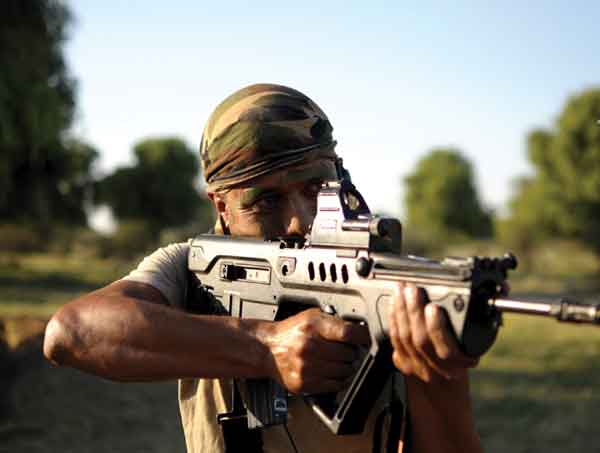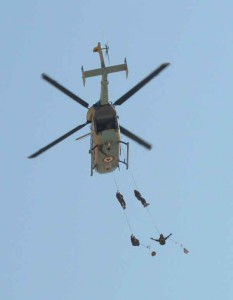Special Forces do not create resistance movements but advice, train and assist resistance movements already in existence. In asymmetric settings, Special Forces have limitless pro-active employment possibilities to exploit dissidence; employ asymmetric approaches from the NBC sphere to psychological operations, information war, economic/technical/ financial war. In counter-terrorism and counter-insurgency, Special Forces can be used for intelligence, surveillance and psychological operations, rival/pseudo gang operations, infiltrating tanzeems, neutralising terrorist leaders, organisations, support groups, infrastructure, selective raids, ambushes, snatch operations and incident response operations. In out-of-area contingencies, they can assist airborne/conventional forces or may be called upon to perform politico-military missions such as providing assistance to third world nations, surgical strikes, recovery missions, prevent terrorist use of WMDs and provide humanitarian assistance.
Special Forces cannot be mass produced and competent Special Forces cannot be created after emergencies arise…
Conceptually, Special Forces should be employed to continuously ‘shape the battlefield’ from conventional wars in nuclear backdrop to asymmetric and fourth generation wars. Their employment should be theatre/region specific and as force multipliers to complement tasks performed by conventional forces, entailing high risk, and high gain missions having minimum visibility with desired effect. Their strategic tasking should be in sync with national security objectives. Since tasking of Special Forces invariably includes Special Operations, Covert Operations and Special Missions, these itself provide the leeway to undertake virtually any strategic task.
Core tasks of foreign Special Forces are direct action, special reconnaissance, foreign internal defence, unconventional warfare, counterterrorism and counter-proliferation of WMDs, civil affairs operations, psychological operations and information operations. It is significant to note that the USSF also undertakes undeclared tasks such as conducting proactive, sustained “man hunt” and disruption operations globally, building partner capacity in relevant ground, air and maritime capabilities in scores of countries on a steady-state basis, helping generate persistent ground, air and maritime surveillance and strike coverage over “under-governed” areas and littoral zones, and employing unconventional warfare against state-sponsored terrorism and trans-national terrorist groups globally.
Additionally, in the Af-Pak region, the CIA had a 3,000-strong army of Counter Terrorism Pursuit Teams (CTPT) that have depleted in Pakistan post the Raymond Davies episode and the killing of Osama-bin-Laden.
Manning
Globally accepted Special Forces truths are – humans are more important than hardware; quality is better than quantity; Special Forces cannot be mass produced; and competent Special Forces cannot be created after emergencies arise. Regrettably, India has ignored these factors. Authorised expansion rate of SOCOM is 1.8 per cent annually though in 2011, this was hiked to 2.5 per cent in 2011, and now there is a bid for an addition of 3,000 which includes ‘support elements’ due to increased responsibilities.
Our Special Forces lack of quality manpower including officers…
Pakistan added the fourth SSG battalion only in recent years. India went in for a 120 per cent increase in the period 2001-2004 alone including converting three parachute battalions to Special Forces. The unprecedented expansion was resorted to by deliberately feeding the hierarchy that 20,000 USSF were operating in Iraq and Afghanistan, which was untrue since this included 82 and 101 AB Divisions of the US. Actually even in the peak period of USSF deployment only 90xOperation Detachments Alpha (ODAs) were actually used (each ODA is 10-12 strong). In terms of expansion, we are making the same mistake in the expansion of the NSG.
Our Special Forces lack quality manpower including officers and shortages are shared with rest of the military, which implies that the significance of Special Forces is little understood.
It is significant to note how seriously the USSF takes the issue of quality manpower. Take, for example, the personnel policies of the SEAL Team 6, which carried out the raid to kill Osama bin Laden. US Navy personnel volunteer for the SEALS and only those who make the cut are inducted. They serve in other SEAL teams for several years gaining operational experience.
Out of this lot, volunteers then opt for SEAL Team 6. It means they are truly the best of the best. Their average age profile is 32 years, which shows they have the right mix of youth and experience. This also underlines the seriousness with which the US develops their SF for various roles. The success of Op Neptune Spear is a testimony to that.
Equipping
Being under different chains of command, there is no commonality in equipment and no concept of ‘packaged equipping’, aside from Specialist/advanced training facilities being inadequate. Packaged equipment is essential because if a sub-unit does not have the complete authorised equipment, its combat capability will obviously be less.
The high level of sophisticated coordination and synergy to pull off Special Forces strategic missions is missing…
The equipment that is lacking presently is in terms of light-weight, hand-held laser target designators, information system package to communicate with required entities to include voice, data, video streaming, light-weight long-range global communications to call multiple weapon strikes, state-of-the-art listening and surveillance devices, from miniature devices hand-held to MAVs, helicopter transportable all terrain vehicles, corner shots, goggles/devices to see through walls, hand-held EW weapons, state-of-the-art explosive devices with long-term timers, all-terrain light-weight clothing and load carriage, latest survival equipment, to name a few.
Integration
India is perhaps the only country whose Special Forces have no centralised command structure. This, plus the lack of strategic culture and prolonged employment in counter-insurgency leaves little scope for specialisation. Resultantly, Army Special Forces are more ‘Jack of all Trades’. MARCOS have limited prowess on land, GARUD are sans specialised air transportation units and their tasking duplicates the tasks of the Army Special Forces.
Integrated and adequate intelligence is not institutionalised. Language training and proficiency is grossly inadequate. There is no concept of integrated or even dedicated air support. There is no concept of ‘support units’ including civilians. The SAGs of NSG and SGs of SFF are not cohesive units since 33 per cent of their manpower is turned over annually. Amongst the various Special Forces there is little or no joint training. The high level of sophisticated coordination and synergy necessary between various political, military, intelligence agencies and other departments to pull off Special Forces strategic missions is missing.
India is perhaps the only country whose Special Forces have no centralised command structure…
There is urgent need to educate and create macro conditions for Special Forces through measures such as creation of a national vision, joint doctrine, joint organisations and integrated intelligence support.
What India needs is Special Forces for strategic tasks including deterrence against irregular and asymmetric warfare, Commando Forces for cross-border tactical tasks and within border tasks beyond the capability of regular infantry and Airborne Forces for rapid reaction and force projection within and outside India.
To begin with, the Special Forces should be organised as a small 200 to 300 strong force with the highest regional specialisation, directly under the highest political authority since most politico-military missions would be without reference to the military because of the sensitive nature. Manpower should be drawn from existing Special Forces plus other all India avenues. They should be tasked with surveillance and target designation in areas of strategic interest, shaping asymmetric and conventional battlefield to Indian advantage, deterring opponents exploiting our faultlines, controlling faultlines of adversaries, undertaking information/psychological operations and unconventional warfare, anti-hijack, building partner capabilities with friendly countries and providing cutting edge for strategic force projection.
Warfare is no longer confined to the battlefield…
The balance of the Commando Forces should be reorganised into an Integrated Commando Command directly under the CDS/Permanent Chairman COSC, integrating the Army Special Forces, MARCOS, Garuds, NSG and the SFF.
Conclusion
There is an urgent need to create a deterrent against irregular and unconventional forces. Pro-active employment of Special Forces can help create such deterrence. While we may continue building military and political will, we must concurrently get on with building this capability.







I love my india
sir,i want join indian special force.plz can i join indian special force.plz information for the full details.specialy 9 para commando.
sir please help me.
Resp sir.
Sir, my age is 26 & i am doing computer oprator job in punjab,
Sir mai indian pera comando me jana chahta hu pr mujhe koi gidence nahi hai.
sir mera sapna hai ki mai is feeld mai jau. to sir please help me. please
sir,i want join indian special force.plz can i join indian special force
sir,i want join indian special force.plz can i join indian special force.plz information for the full details.specialy 9 para commando.
sir
i was really
happy by looking at the indian stf ifell to join and iam a cadet and a scout in my school
Sir i want to join the indian special forces.i want to who are eligible to special forces.
i want join indian special force.how can i join this please inform me full detials.
Sir I feelinig was join in army / special force ,can i join for army .pls information for the full details
It seems that the Indian is least bothered about protecting its strategic interests. Under the guise of covert ops the special forces are surgical tools to ensure protection of Indian strategic interests in cases where mere diplomacy fails. It is shocking to hear that a joint SF command does not even exist. Lets hope that the future sees some change.
The Author has rightly made out a strong case for Increasing the nos & the scope of the special forces..The Havoc that Special forces can do is best given in the 1962 indo-China war. The Chinese special forces bypassed the well entrenched 4 Div. & caused such a panic that the Whole of the Famous 4 Div. Disintegrated,Collapsed & took flight giving a bad reputation to the fighting skills of the Indian army..The Special forces need to be integrated in the fighting units at the mountain brigade level. The Mountain Strike corps should have a Brigade of special forces.Subsequently all strike corps should have one. There is a need for a special Forces Command also.
Lt. Katoch makes a strong point for India’s special forces. The Jihadi’s across the border are in essence a special force wing of the Pakistani military. That is why India is never able to prosecute in courts any of the real actors behind the horific terror violence from Pakistan. These groups carry out the mission of their radicalized army which is incapable of confronting India. To deal with such enemy India needs an ever expanding and evolving special forces to neutralize future attack. We need the best personnel, best equipment and the best training for such an outfit which should be ready to step into action 24/7 in any part of the country. India’s friends in the West, namely, US and Israel are the most experienced, resourced and intelligent about preventing terrorism. They should be solicited to help build a strong special force division as part of the Indian defence structure under a unified command.
Lt. General or General Katoch would be the correct form of address in this case. Major General is best addressed as Major General or simply General.General being the operative word. These are common mistakes made.
Lt. General Katoch indeed. Thank you for the correction.